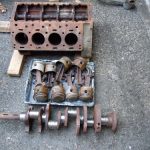We may receive a commission when you use our affiliate links. However, this does not impact our recommendations.
QUESTION: My woodworking shop is going great but I do have a question spurred (proper word choice?) on by your videos and my experience. I have flattened my Lie-Nielsen bench benchtop. Not a terrible job but I did experience tear-out. The top is of course a laminated maple unit four inches thick with a 5″ skirt. Many pieces that compose it have the grain going in alternate directions to ward off warping as the benchtop seasons with regards to humidity and temperature.
When I flattened the benchtop I used the No. 8 with a 45° frog followed by the No 4-1/2 with 50° frog. I experienced tear-out. I used the No. 8 to start as it it very long and will flatten such a large area. I think the angle must be too low for the hard maple. I think I should put a back bevel on the blade. I’ll follow it up with my No. 4 with 55° frog. If this is a good approach what back bevel angle should I put on my No. 8 iron? Anything else to consider?
– Mike Christiano
ANSWER: I’ll be honest here: I have lots of tear-out on my workbenches. It doesn’t affect how they work one bit so I don’t worry about it. There are ways of dealing with the tearing, of course, but a benchtop is fundamentally different than a tabletop. So consider the following.
A dining room tabletop has to look good, but it doesn’t have to be dead flat. It only has to look flat. You can get away with reversing grain problems in the top and use scrapers to remedy the tearing because small low spots left by the scraper don’t affect the dining experience.
A benchtop has to be pretty flat to work well. I’ve found that the critical areas (mostly the front half of the bench) need to be less than .006” flat so your work won’t bow as you plane it. However, the appearance of the benchtop has no bearing on its function.
By treating your bench like it’s both a benchtop and tabletop, you are making it very hard on yourself. You are trying to achieve both flatness and surface perfection.
Personally, I’d rather be building furniture than fussing over the benchtop (and I love workbenches).
But I do want to answer your question. My strategy would be to use a toothed blade in my jointer to get the benchtop flat and free of tearing. Then I’d remove the resulting rough surface with a 55°-pitch smoothing plane.
— Christopher Schwarz
Here are some supplies and tools we find essential in our everyday work around the shop. We may receive a commission from sales referred by our links; however, we have carefully selected these products for their usefulness and quality.










If that tear-out really bothers you, find a friendly cabinet shop and use one of their wide belt sanders!
First I would like to say, I really like your response to the question Chris. Right on!
Second, I just was experimenting planing some very highly figured cherry the other day with the back bevel plane irons etc. I really was not too successful, getting lots of tearout. The best results were actually with my low angle jack plane, (I like the heft of the Lee-Valley one) Sharpen the blade as sharp as you can and close the mouth as tight as you can, set the blade to take off a VERY thin shaving and it worked great, no tear out. If he wants the flatness of a benchtop and the perfection of a table top, this might be another way to go, maybe a low angle jointer with the same set up.
I solved my tearout problems with a phenomenal plane Andrew at Lie-Nielsen recommended, their low angle jack plane with two regular irons and a toothed one. I honed the micro bevels just as Deneb showed in the video, made the opening small and I finally felt like I was advancing my skills. It also made me realize that the excessive tear out I had when I first used the 1923 Stanley #8 could have been lessened by moving the frog forward.
(cue the sound of angels singing and the beam of heavenly light breaking through the clouds and landing on my workbench) Thank you! Last year I built a bench based on Robert Lang’s 21st Century workbench design out of Australian red gum (eucalyptus) hardwoods left over from my housebuilding. I have been real happy with the bench – but always embarrassed, frustrated and feeling like a failure for being unable to remove the tearout from the top. After numerous attempts over several months (darn it, I’m going to get it right this time!) eventually I just aimed for flat and stopped trying. What joy to have the blessing of ‘the Schwarz’ on my conclusion!
Thank you so much for both the question and the answer here. Last year, I decided to try and flatten my workbench top using a couple of vintage wooden planes, a jack plane and a jointer. I have little experience with either, but at least they have nice sharp blades now. My flattening did improve the workbench top, which is oak, but, boy, did I get tear out. While I am sure that I could have done a better job, it’s nice to know that I’m not the only one who runs in to this problem. But I do need to get myself some napkins.
I had no idea LN had toothed blades for their bench planes. Knowing is half the battle (ordering the other half)!
I find that a workbench is great at being a bench top and a table top, especially during lunch time in the shop! (just put a napkin down first to catch the burrito drippings)